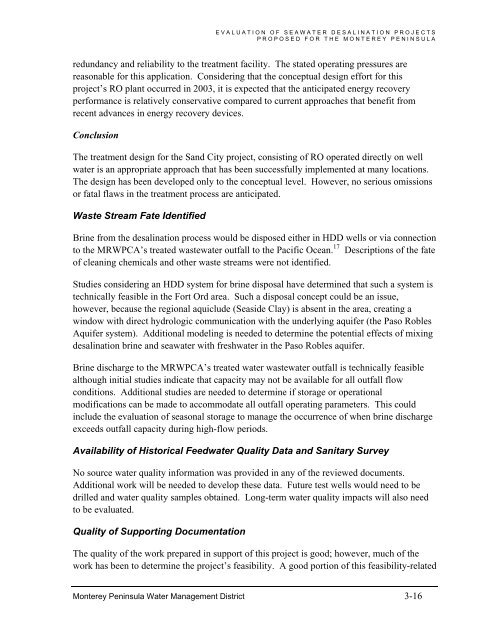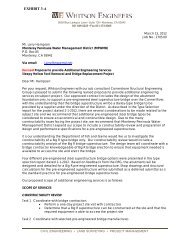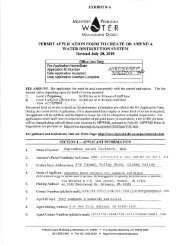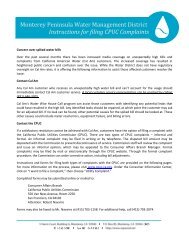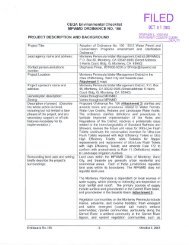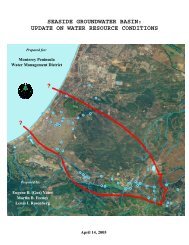FINAL REPORT Evaluation of Seawater Desalination Projects ...
FINAL REPORT Evaluation of Seawater Desalination Projects ...
FINAL REPORT Evaluation of Seawater Desalination Projects ...
Create successful ePaper yourself
Turn your PDF publications into a flip-book with our unique Google optimized e-Paper software.
EVALUATION OF SEAWATER DESALINATION PROJECTS<br />
PROPOSED FOR THE MONTEREY PENINSULA<br />
redundancy and reliability to the treatment facility. The stated operating pressures are<br />
reasonable for this application. Considering that the conceptual design effort for this<br />
project’s RO plant occurred in 2003, it is expected that the anticipated energy recovery<br />
performance is relatively conservative compared to current approaches that benefit from<br />
recent advances in energy recovery devices.<br />
Conclusion<br />
The treatment design for the Sand City project, consisting <strong>of</strong> RO operated directly on well<br />
water is an appropriate approach that has been successfully implemented at many locations.<br />
The design has been developed only to the conceptual level. However, no serious omissions<br />
or fatal flaws in the treatment process are anticipated.<br />
Waste Stream Fate Identified<br />
Brine from the desalination process would be disposed either in HDD wells or via connection<br />
to the MRWPCA’s treated wastewater outfall to the Pacific Ocean. 17 Descriptions <strong>of</strong> the fate<br />
<strong>of</strong> cleaning chemicals and other waste streams were not identified.<br />
Studies considering an HDD system for brine disposal have determined that such a system is<br />
technically feasible in the Fort Ord area. Such a disposal concept could be an issue,<br />
however, because the regional aquiclude (Seaside Clay) is absent in the area, creating a<br />
window with direct hydrologic communication with the underlying aquifer (the Paso Robles<br />
Aquifer system). Additional modeling is needed to determine the potential effects <strong>of</strong> mixing<br />
desalination brine and seawater with freshwater in the Paso Robles aquifer.<br />
Brine discharge to the MRWPCA’s treated water wastewater outfall is technically feasible<br />
although initial studies indicate that capacity may not be available for all outfall flow<br />
conditions. Additional studies are needed to determine if storage or operational<br />
modifications can be made to accommodate all outfall operating parameters. This could<br />
include the evaluation <strong>of</strong> seasonal storage to manage the occurrence <strong>of</strong> when brine discharge<br />
exceeds outfall capacity during high-flow periods.<br />
Availability <strong>of</strong> Historical Feedwater Quality Data and Sanitary Survey<br />
No source water quality information was provided in any <strong>of</strong> the reviewed documents.<br />
Additional work will be needed to develop these data. Future test wells would need to be<br />
drilled and water quality samples obtained. Long-term water quality impacts will also need<br />
to be evaluated.<br />
Quality <strong>of</strong> Supporting Documentation<br />
The quality <strong>of</strong> the work prepared in support <strong>of</strong> this project is good; however, much <strong>of</strong> the<br />
work has been to determine the project’s feasibility. A good portion <strong>of</strong> this feasibility-related<br />
Monterey Peninsula Water Management District 3-16


